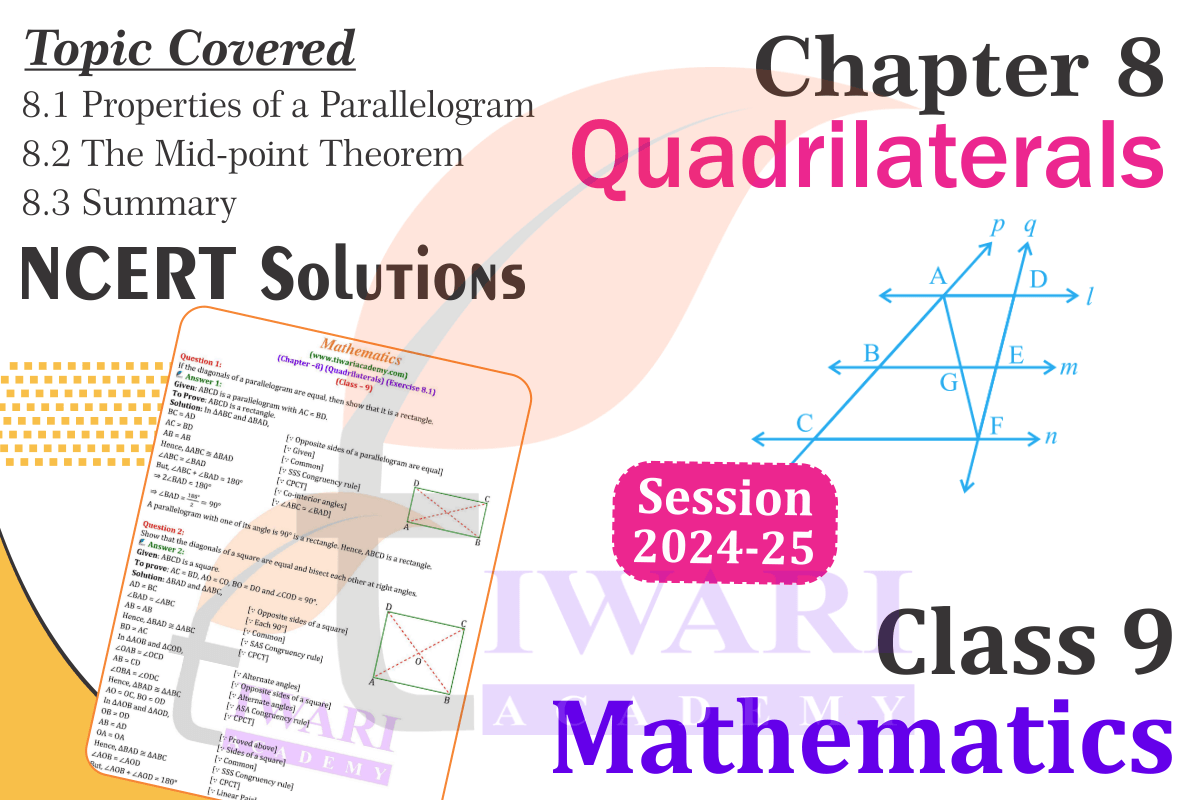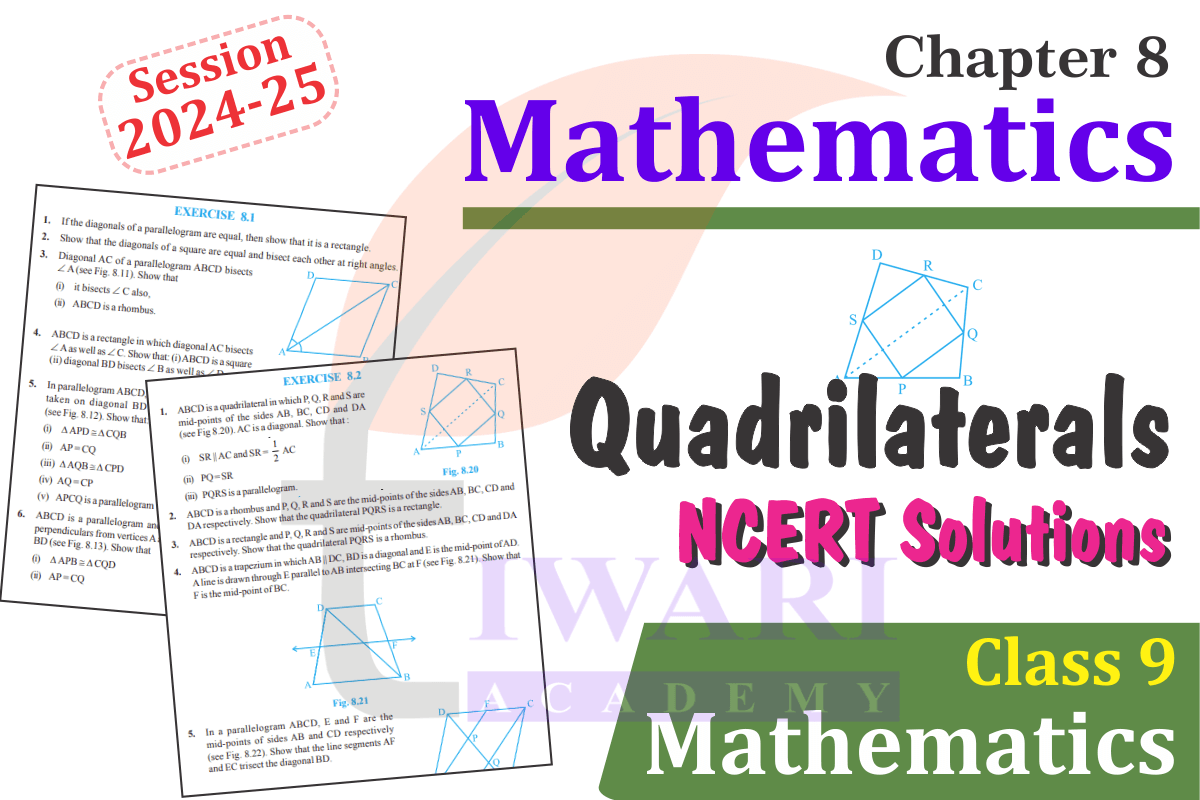NCERT Solutions for Class 9 Maths Chapter 8 Quadrilaterals in English Medium and Hindi Medium updated for new session 2025-26. NCERT Updated Solutions for Class 9 Mathematics Chapter 8 Quadrilaterals provide comprehensive guidance for students learning about this essential geometry topic. With the detailed Class 9 NCERT Maths Textbook Chapter 8 Solutions, students can explore the properties and theorems of quadrilaterals step-by-step. Whether you’re working on Quadrilaterals NCERT Maths Exercise 8.1 Solutions or Quadrilaterals CBSE Book Exercise 8.2 Solutions, these NCERT solutions simplify complex problems into easy-to-follow steps.
Class 9 Maths Chapter 8 Solutions: English Medium
NCERT Class 9th Math Quadrilaterals PDF includes diagrams, explanations, and examples tailored to meet academic requirements. These solutions also highlight Quadrilaterals Properties Class 9 Math, enabling a better understanding of parallelograms, trapeziums and kites. The Class 9 Maths Mathematics Chapter 8 Notes consolidate the key takeaways, offering a quick revision resource. By using the NCERT Exercise Solutions for Quadrilaterals, students not only solve problems efficiently but also strengthen their conceptual knowledge. Educational platform Tiwari Academy including apps, incorporate visual aids like diagrams, graphs and charts to illustrate mathematical concepts. Visual aids can enhance understanding and retention, especially for visual learners.
Class 9 Maths Exercise 8.1 in English
Class 9 Maths Exercise 8.2 in English
For those looking to excel in their geometry skills, the NCERT Class 9th Maths Book Chapter 8 PDF Download is a must-have resource. NCERT 9th Mathematics textbook solutions delve into all aspects of Quadrilaterals NCERT Solutions PDF, offering clarity on Class 9 Math Assignment Chapter 8 Examples and exercises. Students preparing for exams will find the Quadrilaterals Important Questions NCERT Grade 9th invaluable for practice. The solutions also explain critical theorems covered in the Class 9 Mathematics Book Chapter 8 Theorems section, such as the properties of diagonals and angles in various quadrilaterals.
Class 9 Maths Chapter 8 Solutions: Hindi Medium
Whether tackling Class 9 Math Complete Chapter 8 Problem Solutions or studying detailed proofs, the NCERT material is structured to provide complete understanding. The CBSE Class 9 Maths Revised Chapter 8 Practice Questions ensure students test their grasp of the subject effectively, helping them ace exams confidently. Tiwari Academy’s online platform allows students to access study materials anytime and anywhere with an internet connection. This flexibility can make it easier for students to study at their own pace and convenience.
Class 9 Maths Exercise 8.1 in Hindi
Class 9 Maths Exercise 8.2 in Hindi
NCERT Solutions for Class 9 Maths Chapter 8
NCERT Class 9 Mathematics Textbook Solutions Chapter 8 serves as a reliable companion for mastering the intricacies of quadrilaterals. Through the Class 9 Math Course Book Chapter 8 Study Material, students gain insights into solving advanced problems with ease. The Quadrilaterals Class 9 NCERT Maths Solutions PDF is organized to support learning at every step, breaking down topics like Quadrilaterals Properties Class 9 into manageable parts.
These resources also include solutions for tricky questions in the Quadrilaterals Class 9 NCERT Mathematics Solutions, providing clarity and boosting confidence. By reviewing the CBSE Class 9th Math Chapter 8 Notes, students can quickly revise key points before exams. The Quadrilaterals Class 9 Maths Exercise Solutions help reinforce learning through practical application. With the NCERT Class 9 Math Textbook Chapter 8 Solutions, students develop a deeper understanding of quadrilaterals, enhancing their overall mathematical proficiency.
| Class: 9 | Mathematics |
| Chapter: 8 | NCERT Solutions and Extra Questions |
| Number of Exercises: | 2 (Two) |
| Topic: | Quadrilaterals |
| Content Mode: | Videos and Text |
| Session: | Academic Year 2025-26 |
| Medium: | English and Hindi Medium |
Important Points in Class 9 Maths Chapter 8: Quadrilaterals for Exams
Definitions and properties of quadrilaterals, including parallelograms, rhombuses, rectangles and squares.
Key theorems like the mid-point theorem and properties of diagonals.
Practical applications in Quadrilaterals Exercise 8.1 and Exercise 8.2.
Importance of solving NCERT Class 9 Maths Examples and practice questions.
| Day | Topic | Resources | Activity |
|---|---|---|---|
| Day 1 | Introduction to Quadrilaterals | NCERT Textbook, Class Notes | Read definitions, understand types and properties |
| Day 2 | Key Theorems | NCERT Chapter 8 Theorems | Study theorems like the mid-point theorem, practice diagrams |
| Day 3 | Exercise 8.1 | NCERT Solutions, Practice Questions | Solve Exercise 8.1 problems and review solutions |
| Day 4 | Exercise 8.2 | NCERT Solutions, Practice Questions | Solve Exercise 8.2 problems and review solutions |
| Day 5 | Important Questions | Class Notes, Previous Year Papers | Attempt important and previous year questions |
| Day 6 | Revision | NCERT Chapter 8 Notes | Revise concepts, theorems and practice questions |

UP Board students are now using NCERT Books for UP board course. So, they also take the help from these 9th Maths solutions. Download UP Board Solutions for class 9 Maths Chapter 8 in Hindi Medium free. Class 9 Maths Solutions are in Hindi Medium and English Medium for all the students following NCERT Books for the academic session 2025-26. NCERT (https://ncert.nic.in/) Solutions for all other subjects are also available in downloadable form. Videos related to each questions and Ex. 8.1 and Ex. 8.2 are also given with complete descriptions. Download Class 9 Maths App for Offline use or Download Kaksha 9 Ganit App for offline use.
Study Material for Class 9 Maths Chapter 8
9th Maths Chapter 8 Solutions in English & Hindi Medium
NCERT Solutions for Class 9 Maths Chapter 8 Exercise 8.1 & 8.2 sols in English as well as medium for CBSE, UP Board, Uttarakhand, Bihar and Gujrat board, wherever the NCERT Books 2025-26 are prescribed as a course book. Download Offline Apps for session 2025-26, which work well even without internet.
Class 9 Maths Exercise 8.1 Solution in Hindi Medium

Class 9 Maths Chapter 8 Practice Questions with Solution
What are the properties of a parallelogram?
In a parallelogram
Opposite sides are equal
Opposite angles are equal
Diagonals bisect each other.
In which type of quadrilaterals, diagonals bisect each other?
The diagonals of following quadrilateral bisect each other:
Parallelogram
Rectangle
Square
Rhombus
Important Notes on 9th Maths Chapter 8
1. Sum of the all angles of a quadrilateral is 360.
2. A quadrilateral in which one pair of opposite sides are parallel, is called trapezium.
3. A quadrilateral in which both pairs of opposite sides are parallel, is called parallelogram.
4. A parallelogram in which one of its angle is right angle, is called a rectangle.
5. A parallelogram in which all side are equal, is called rhombus.
Important Questions on 9th Maths Chapter 8
The angles of quadrilateral are in the ratio 3 : 5 : 9 : 13. Find all the angles of the quadrilateral.
Let the first angle = 3x
Therefore,
the second angle = 5x,
Third angle = 9x and
Fourth angle = 13x
Sum of all angles of a quadrilateral is 360°.
Therefore, 3x + 5x + 9x + 13x = 360°
⇒ 30x = 360°
⇒ x = (360°)/30 =12°
Hence,
The first angle = 3 × 12° =36°,
The second angle = 5 × 12° = 60°,
Third angle = 9 × 12° = 108°
The forth angle = 13 × 12° = 156°
If the diagonals of a parallelogram are equal, then show that it is a rectangle.
Given: ABCD is a parallelogram with AC = BD.
To Prove: ABCD is a rectangle.
Solution: In ΔABC and ΔBAD,
BC = AD [∵ Opposite sides of a parallelogram are equal]
AC = BD [∵ Given] AB = AB [∵ Common]
Hence, ΔABC ≅ ΔBAD [∵SSS Congruency rule]
∠ABC = ∠BAD [∵ CPCT] But, ∠ABC + ∠BAD = 180° [∵ Co-interior angles]
⇒ 2∠BAD = 180° [∵ ∠ABC = ∠BAD]
⇒ ∠BAD = (180°)/2 = 90°
A parallelogram with one of its angle is 90° is a rectangle.
Hence, ABCD is a rectangle.
Show that if the diagonals of a quadrilateral bisect each other at right angles, then it is a rhombus.
Given: ABCD is a quadrilateral in which AO = CO, BO = DO and ∠COD = 90°.
To prove: ABCD is a rhombus.
Solution: In ΔAOB and ΔAOD,
BO = DO [∵ Given]
∠AOB = ∠AOD [∵ Each 90°]
AO = AO [∵ Common]
Hence, ΔAOB ≅ ΔAOD [∵SAS Congruency rule]
AB = AD [∵ CPCT]
Similarly, AB = BC and BC = CD
Now, all the four sides of quadrilateral ABCD are equal.
Hence, ABCD is a rhombus.
6. A rectangle with all sides equal, is a square.
7. Diagonals of parallelogram divides it into two congruent triangles.
8. The line segment joining the mid-points of two sides of a triangle is parallel to the third side and is half of it.
9. A line drawn through the mid-point of a side of a triangle parallel to another side bisects the third side.
10. The quadrilateral formed by joining the mid-points of the sides of a quadrilateral, taken in order, is a parallelogram.
The benefits of NCERT Solutions for Class 9 Maths Chapter 8 Quadrilaterals
NCERT Textbook Solutions for Class 9 Maths Chapter 8 Quadrilaterals provide a comprehensive approach to understanding this critical topic. They simplify the concepts of Quadrilaterals Properties Class 9, ensuring students can solve problems with ease. Whether it’s Quadrilaterals Exercise 8.1 Solutions or Quadrilaterals Exercise 8.2 Solutions, the step-by-step guidance helps in grasping theorems, properties and examples effectively. The Class 9 Maths Chapter 8 Notes offer concise yet detailed explanations for quick revision. Additionally, the Quadrilaterals Class 9 Exercise Solutions ensure practical application of concepts, helping students strengthen their foundation in geometry and excel in exams.
Topics covered in the Class 9 Maths Chapter 8 Notes on Quadrilaterals
Class 9 Maths Textbook Chapter 8 Notes on quadrilaterals are a valuable resource for exam preparation. They provide summaries of theorems, properties and examples, such as Class 9 Maths Chapter 8 Theorems, ensuring clarity and understanding. These notes also include key concepts from Quadrilaterals Properties Class 9 to help students tackle practical questions. Paired with the Class 9 NCERT Maths Chapter 8 Study Material, these notes are ideal for last-minute revision. Solutions for Quadrilaterals Exercise 8.1 Solutions and Quadrilaterals NCERT Exercise 8.2 Solutions are also covered, ensuring students are fully prepared for exams.
Where can I find Quadrilaterals NCERT Solutions PDF for Class 9 Maths Chapter 8?
Quadrilaterals NCERT Textbook Solutions PDF for Class 9 Mathematics Chapter 8 Quadrilaterals is readily available for download on various educational platforms. These resources include solutions for Class 9 Maths Chapter 8 Examples, exercises and critical questions like Quadrilaterals Important Questions Class 9. By downloading the NCERT Class 9 Maths Chapter 8 PDF, students gain access to high-quality material that simplifies complex geometry problems. The solutions cover all exercises, including Class 9 Maths Chapter 8 Problem Solutions, offering clarity and helping students improve their problem-solving skills.
How many questions and examples are there in chapter 8, Quadrilaterals of 9th Maths?
Chapter 8 Quadrilaterals of 9th Maths has two exercises. In the first exercise (Ex 8.1), there are 6 examples and 12 questions. The second exercise (Ex 8.2) contains two examples and 7 questions. So, there are 8 examples and 19 questions in chapter 8.
How can NCERT Class 9 Maths Solutions Chapter 8 help in exam preparation?
The NCERT Textbook Class 9 Maths Solutions Chapter 8 is a comprehensive guide that ensures students understand the core concepts of quadrilaterals. With detailed explanations of Quadrilaterals Properties Class 9, the solutions simplify challenging exercises such as Class 9 Maths Chapter 8 Problem Solutions. The inclusion of Quadrilaterals Important Questions Class 9 and Class 9 Maths Chapter 8 Practice Questions helps students identify and focus on high-priority topics. These solutions provide clarity on every topic, enabling students to answer confidently and achieve higher scores in exams.
What are the main topics that students will study in chapter 8 of grade 9th Maths?
Topics that students will study in chapter 8 of grade 9th Maths are:
- 1. Meaning of quadrilateral.
- 2. Angle sum property of a quadrilateral.
- 3. Types of quadrilateral (Trapezium, Parallelogram, Rectangle, Rhombus, Square, Kite).
- 4. Area of a Parallelogram.
- 5. Properties of a parallelogram.
- 6. The Mid-point theorem.
- 7. The converse of Mid-point theorem.
What resources are included in the Quadrilaterals Class 9 Solutions PDF?
NCERT Textbook Quadrilaterals Class 9th Mathematics Solutions PDF includes all essential resources for mastering Chapter 8 of Class 9 Maths. It covers detailed explanations of Class 9 Maths Chapter 8 Theorems, solutions for Class 9 Maths Chapter 8 Examples, and practice exercises. The PDF also features the NCERT Class 9 Maths Solutions Chapter 8, which ensures clarity on key topics such as Quadrilaterals Properties Class 9. With additional support from Class 9 Math Chapter 8 Study Material, this PDF equips students with the tools they need for comprehensive learning and exam success.
What are some real-life examples in Chapter 8 of 9th Maths quadrilaterals?
Some real-life examples of quadrilaterals are:
- The floor.
- Walls.
- Ceiling.
- Windows of your classroom.
- The blackboard.
- Each face of the duster.
- Each page of your book.
- The top of your study table.
Is chapter 8 Quadrilaterals of class 9th Maths easy or difficult to solve and understand?
Chapter 8 of class 9th maths is a little difficult to solve and understand because this chapter contains proving questions. However, the difficulty level of any topic varies from student to student. So, Chapter 8 of class 9th maths is easy or difficult depends on students also. Some students find it difficult, and some find it easy.
Does chapter 8 of class 9th Maths contain any theorem?
Yes, chapter 8 of class 9th Maths contains theorems. There are ten theorems in chapter 8. All the theorems are nice and easy.


